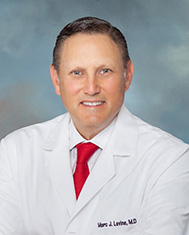4 Ways to Prevent Golf Injuries
 For golfers this summer, sand traps aren’t the only hazards to avoid. “Low back pain is common, especially in golfers over 50,” says Marc J. Levine, MD, Chief of Orthopedic Surgery and Director of Spine Surgery at Robert Wood Johnson University Hamilton (RWJUH Hamilton), a member of RWJBarnabas Health Medical Group and a clinical assistant professor at Rutgers New Jersey Medical School. Most low-back injuries in golfers, Dr. Levine says, stem from stress on the spine associated with swinging a golf club. “Often, pain remains localized to the lower back, but occasionally it can become sciatic and radiate down one or both legs,” he says.
For golfers this summer, sand traps aren’t the only hazards to avoid. “Low back pain is common, especially in golfers over 50,” says Marc J. Levine, MD, Chief of Orthopedic Surgery and Director of Spine Surgery at Robert Wood Johnson University Hamilton (RWJUH Hamilton), a member of RWJBarnabas Health Medical Group and a clinical assistant professor at Rutgers New Jersey Medical School. Most low-back injuries in golfers, Dr. Levine says, stem from stress on the spine associated with swinging a golf club. “Often, pain remains localized to the lower back, but occasionally it can become sciatic and radiate down one or both legs,” he says.
Most low-back injuries in golfers, Dr. Levine says, stem from stress on the spine associated with swinging a golf club. “Often, pain remains localized to the lower back, but occasionally it can become sciatic and radiate down one or both legs,” he says.
He offers these tips for warding off back injuries on the links:
• Don’t emulate the pros. Many professional golfers today use the “modern golf swing,” keeping their hips stationary, twisting their upper body and following through forcefully. While it may make a golf ball travel farther, “The thoracic and lumbar spine can’t absorb that kind of force regularly, especially if you’re over age 50,” Dr. Levine says. A safer approach is to use a swing that’s comfortable for you and to have realistic expectations about how far you can drive a golf ball.
• Keep your swing consistent. “Your body likes predictability,” Dr. Levine says. “Every time you jerk or move unexpectedly, it creates more strain on your back.” Dr. Levine recommends meeting with a golf pro at least once a year to evaluate your swing. Ask for tips to improve your mechanics and ergonomics.
• Stay physically fit. A regular exercise routine can strengthen core muscles, including those in your abdomen and back. “Also, do stretching exercises for at least five to 10 minutes before you start each round of golf,” Dr. Levine says.
• Use the right equipment. “Choose shoes that will help you stabilize your feet, so you don’t lose traction,” Dr. Levine says. If you’re thinking about new clubs, look for ones with less rigidity in the shaft. “That will absorb some of the energy when you take a backswing and may create less force on your spine,” Dr. Levine says.
If you feel a twinge of back pain after a round of golf, Dr. Levine recommends rest, ice and over-the-counter anti-inflammatory medicines (aspirin, ibuprofen) as a first line of treatment. See a doctor if pain continues for four to six weeks. “If you experience any numbness, tingling or weakness, get evaluated by an orthopedic surgeon,” Dr. Levine says.
Dr. Levine sees patients at The Orthopedic & Spine Institute located at RWJUH Hamilton, 1 Hamilton Health Place, Hamilton Township, NJ. Call 609-689-7031 to make an appointment.
Learn more at rwjbh.org
Require rehabilitation or physical therapy, visit rwjbh.org/rehab to book an appointment and find a location near you.
Let’s be healthy together.